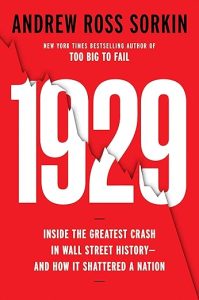Viking
Review by Mark Mansour

Andrew Ross Sorkin’s “1929” is a compelling and vivid chronicle of the most notorious financial crash in history, skillfully blending drama and meticulously researched history to immerse readers in the world of Wall Street at its most precarious. I got my copy last Tuesday and read it cover to cover in the ensuing week. Compelling is an understatement.
Unlike more clinical economic accounts, Sorkin brings the era’s personalities—audacious bankers, ambitious policymakers, and everyday investors—to life, tracing their triumphs and tragedies with narrative flair. His portrait of the crash is both deeply human and sharply analytical, revealing the blend of optimism, hubris, and regulatory blind spots that led an entire nation into economic chaos.
What sets Sorkin apart is his ability to make the complexity of financial markets both accessible and thrilling. Readers are swept up in the action, from the breathless rise and catastrophic fall of stock prices to the personal decisions and private conversations that shaped the fate of millions. Each chapter anchors the story with familiar figures whose actions reverberate through the unfolding drama, grounding the narrative as it navigates through shifting fortunes and bold reforms.
Equally powerful is Sorkin’s treatment of the crash’s aftermath, showing how the failures of 1929 prompted seismic changes in regulation, banking, and government oversight. He takes readers beyond Black Tuesday, chronicling the critical reforms that sought to tame Wall Street’s excesses and restore public trust, and capturing the societal transformation that followed. The lens is as much on the people as the policies—with reflections on how hope and folly, wisdom and ego, all shaped the world that emerged from the rubble.
Sorkin’s book isn’t simply a recounting of the past—it offers insights that remain deeply relevant today. The rhythms of speculation, the dangers of financial euphoria, and the recurring temptation to believe “this time is different” are themes that echo in contemporary financial debate. Sorkin subtly invites readers to draw their own connections, providing the context and detail needed to recognize the warning signs of unchecked optimism and systemic vulnerability, but without heavy-handed comparisons.
For anyone seeking not just to understand a pivotal event but also to appreciate the enduring lessons of financial cycles, “1929” delivers a highly readable experience—a history that resonates far beyond its era.
